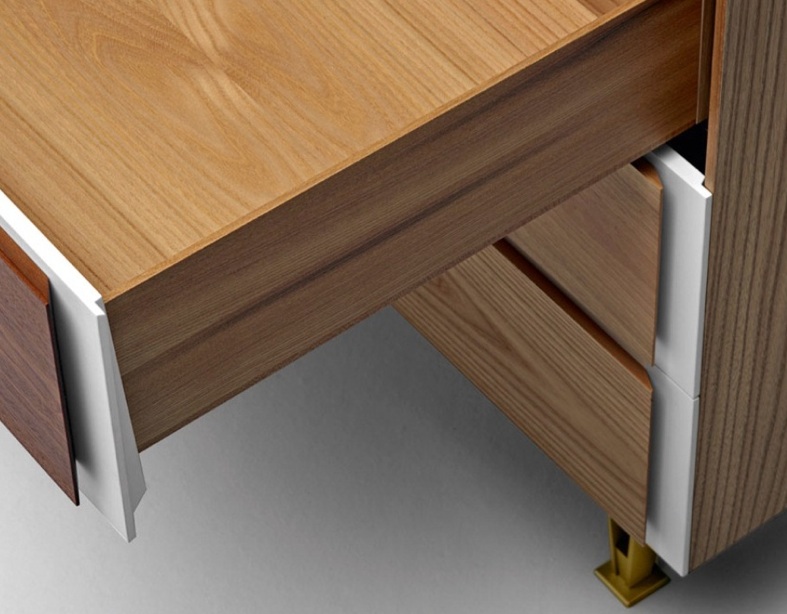Recently the Italian Cultural Institute of New York exhibited the houses inhabited by Gio Ponti and the furniture he designed out of experiments in domestic life and architecture for both working and living. As a collector of Gio Ponti’s furniture, fabrics and over twenty five books on his architecture and design, I can truly say he is one of the main sources of inspiration in my work. Last year on a trip to Milan I had the good fortune of meeting his grandson Salvatore Licitra at Ponti’s studio on via Dezza. After being buzzed into the gate in the same building where Ponti lived, Salvatore shared with me more of Ponti’s work and archive and it was one of the most thrilling experiences I have ever had. To be in the space he worked in with the irregular geometric multi-colored marble floor and see some of his furnishings and drafting tables all preserved immaculately was really quite surreal. So when I heard last year that Molteni&C were working with the Ponti family and archives to reissue 6 pieces this year in Milan I was more than excited and the first in line to see the newly produced work. Following is an excerpt from the show at the Italian Cultural Institute and the reasoning behind why this collection is so relevant now, almost sixty years later.
Gio Ponti with his family at home
“Living alla Ponti was born from an impossible encounter with Gio Ponti: the architect, the man that we would have liked to interview, look into his eyes, and see at work. This encounter took place thanks to Lisa, Letizia, Giulio, Salvatore and Paolo, his children and grandchildren and nieces and nephews but also through drawings, photographs, family albums, letters, and words that Gio Ponti scattered in over 50 year of work. He bears witness to his time, aware the worth of his work. The reason for this encounter was the reissue of Gio Ponti’s furnishings which Molteni&C started two years ago. This piqued curiosity about reconstructing the historical and cultural setting where those furnishings were born, understanding the professional needs and the technical solutions, interviewing the collaborators, and writing the history of the design with the evidence, traces and clues found in the Gio Ponti Archives and CSAC – Study Centre and Communication Archive in Parma. Some of these many documents appear in this small traveling exhibition.”
The Gio Ponti collection for Molteni displayed at the Italian Cultural Institute
This research approach revealed an unknown Ponti, a more intimate, less official one. Inside his homes, the Milanese homes of the Ponti family on Via Randaccio, via Brin, and then via Dezza, but even inside the Ponti Studio among drafting tables and editors of Domus and friends like Bruno Munari who measured the floor with a yardstick, we collected threads of history. Then we made a trip to the country house in Civate, along with architects Figini and Pollini and family. We gathered fragments of life, and rewove the threads of stories. Finally, we concluded with his first designs for the workplace, among the desks of the Montecatini Building, the better known Pirelli offices, and in the company of the young ladies of the 1950’s at the Vembi-Burroughs company. These places were thought out for the people who live them, for the happiness of children, the comfort of office workers, and the efficiency of work. These are places where architecture, interiors, and furnishings harmoniously come together, designed to Live all Ponti.”
Molteni&C d.655.1 chest of drawers by Gio Ponti 1952-1955
Detail of chest in elm and mahogany woods and white lacquer with brass feet
Original drawings of the chest of drawers and details of the materials used
The new Molteni&C collection consists of seven pieces designed by Gio Ponti between 1935 and 1955. The oldest piece in the collection is the Montecatini chair designed for the rst. Palazzo Montecatini in Milan in 1935. Made entirely of polished aluminum the structure seat and back of the chair fabricated in extruded folded aluminum and the glossy finish created by mechanical brushing and polishing. There are two sizes of the chest of drawers originally executed from 1952-1955 in different variations featuring applied wooden handles in elm, Italian walnut, mahogany and rosewood over a white lacquer wooden frame with satin brass splayed feet, one of Pont’s design trademarks. The bookcase was originally designed for the Casa Ponti on via Dezza in 1956-1957 and is made of multi-layer elm wood and white lacquered wood. The pony skin rug, designed in 1954 is made up of several different cattle hide pony skin colors with a linen blend under layer. The coffee table made of painted metal in red, black, gray and white with a clear crystal top was also designed in 1954-1955 again for Ponti’s house in via Dezza. The armchair designed in 1953 comes in a blue and white leather combination with satin brass legs and armrests as well as a limited edition version in a reintroduced velvet by Rubelli. And lastly there are a series of mirrored frames designed in 1954 in white hand painted wood.
Polished aluminum Montecatini chair
Bookcase designed in 1956-1957 in elm and white lacquer
Pony skin rug in black, two natural shades and white designed in 1954
Ponti reclining in the armchair at home
The collection is now available at Molteni&C www.molteni.it













